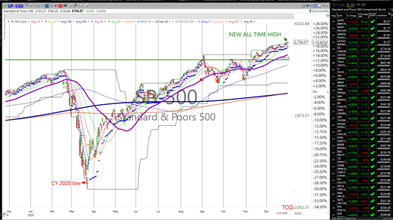Last week, the January stock market decline was interrupted by a Friday afternoon rally.
“The S&P 500 rose 2.4 percent, its biggest one-day jump since June 2020, while the technology-heavy Nasdaq composite rose 3.1 percent. Friday’s gain snapped a three-day streak of losses and left the S&P 500 up 0.8 percent for the week, its first weekly gain this year,” reported Coral Murphy Marcos of The New York Times.
The change in direction may have reflected:
- Confidence in the resilience of the U.S. economy. The U.S. economy grew 6.9 percent in the fourth quarter of 2021, despite the spread of the Omicron variant. Over the full year, the economy expanded by 5.7 percent. It was the strongest quarterly growth since 1972 and the strongest annual growth since 1984, reported the Bureau of Economic Analysis.
- Strong corporate profits. One-third of the companies in the Standard & Poor’s 500 Index have shared how well they did during the fourth quarter. So far, profits were up about 24 percent for the quarter and more than 45 percent for the full year, as measured by the blended earnings growth rate. Above-average earnings growth reflects easy comparisons to weaker earnings in 2020, as well as strong earnings growth in 2021, reported to John Butters of FactSet.
- A buy-the-dip impulse. After three consecutive weeks of declines, the S&P 500 is down about 7 percent for the year. Some investors may have identified buying opportunities created as the market repriced in anticipation of rising interest rates.
It’s difficult to know which direction markets will go next; however, an asset manager cited by Nicholas Jasinski of Barron’s characterized the January drop as:
“…a ‘garden variety technical correction,’ as opposed to a more pernicious cyclical downturn or systemic problem facing the market. Stocks aren’t falling because analysts are lowering profit forecasts en masse, or because economists are predicting a recession on the horizon. Instead, the correction has taken place because of how richly the market is valued.”
Major U.S. stock indices were flat or up for the week, according to Al Root of Barron’s. The yield on 10-year U.S. Treasuries rose during the week before subsiding
What do you know about the space economy? Space exploration is making a comeback.
Bill Nye, the Science Guy, and Ms. Frizzle of Magic School Bus fame both have series featuring outer space. Venture capital firms have begun to spend more than ever before on space companies. They invested $17.1 billion in 2021, up from $9.1 billion in 2020, reported Space Investment Quarterly. And the Bureau of Economic Analysis has begun developing statistics to measure the contributions of space-related industries to the U.S. economy.
See what you know about the space economy by taking this brief quiz.
- At the end of 2021, how many active satellites were in orbit around the Earth?
- 100 to 500
- 500 to 5,000
- 5,000 to 10,000
- More than 10,000
- In 2019, a European spacecraft had to perform an evasive maneuver to avoid a collision with to a private company’s satellite. As the space economy grows and space gets more crowded, the world may need:
- Space traffic awareness
- A regulatory framework defining space rights of way
- Cooperation between multiple nations
- All of the above
- Which country has an ambitious five-year plan for spaceflight and exploration?
- United States
- Russia
- China
- Sweden
- Several companies are using satellite technology to search for solutions to climate issues. These companies are:
- Monitoring global emissions
- Improving agricultural crop growth
- Identifying targets for conservation and reforestation investment
- All of the above
Weekly Focus – Think About It
“The Earth is the cradle of humanity, but mankind cannot stay in the cradle forever.”
—Konstantin Tsiolkovsky,scientist
Answers: 1) c; 2) d; 3) c; 4) d
How Are Your Investments Doing Lately? Receive A Free, No-Obligation 2nd Opinion On Your Investment Portfolio >
Most Popular Financial Stories
Don’t forget about your 2020 IRA contributions!
There’s still time to contribute to your IRA!If you haven’t already contributed to an IRA (Individual Retirement Account), there’s still time to do so. Many...
Special Edition from Jack – the 45 DAY REPORT!
Special Edition from Jack – the 45 DAY REPORT! Friends and Clients, Hard to believe, isn’t it? The first quarter is half over. The year is 45 days old. It’s 1/8th over...
Valentine’s Day Message
How Are Your Investments Doing Lately? Receive A Free, No-Obligation 2nd Opinion On Your Investment Portfolio > December 9, 2020 Our Mission Is To Create And Preserve...
SPECIAL EDITION MARKET UPDATE
How Long Can This Last?Performance NumbersOur aggressive growth model is once again outpacing the S&P 500 Index. We’re up 8.48% year-to-date, while the...
When the Year Is New
Time to Take Stock Bye-bye 2020. For everything not financial, we don’t hate to see you go. Pandemics. Riots. Elections. Safe Distancing. Masks. Lockdowns. The parade of...
Special Edition – Year End Tax Matters
Making a List and Checking It TwiceAs one of the strangest years ever thankfully draws to a close, it behooves us to take stock and see our situation as it now...
Investment advice offered through Research Financial Strategies, a registered investment advisor.
* This newsletter and commentary expressed should not be construed as investment advice.
* Government bonds and Treasury Bills are guaranteed by the U.S. government as to the timely payment of principal and interest and, if held to maturity, offer a fixed rate of return and fixed principal value. However, the value of fund shares is not guaranteed and will fluctuate.
* Corporate bonds are considered higher risk than government bonds but normally offer a higher yield and are subject to market, interest rate and credit risk as well as additional risks based on the quality of issuer coupon rate, price, yield, maturity, and redemption features.
* The Standard & Poor’s 500 (S&P 500) is an unmanaged group of securities considered to be representative of the stock market in general. You cannot invest directly in this index.
* All indexes referenced are unmanaged. The volatility of indexes could be materially different from that of a client’s portfolio. Unmanaged index returns do not reflect fees, expenses, or sales charges. Index performance is not indicative of the performance of any investment. You cannot invest directly in an index.
* The Dow Jones Global ex-U.S. Index covers approximately 95% of the market capitalization of the 45 developed and emerging countries included in the Index.
* The 10-year Treasury Note represents debt owed by the United States Treasury to the public. Since the U.S. Government is seen as a risk-free borrower, investors use the 10-year Treasury Note as a benchmark for the long-term bond market.
* Gold represents the afternoon gold price as reported by the London Bullion Market Association. The gold price is set twice daily by the London Gold Fixing Company at 10:30 and 15:00 and is expressed in U.S. dollars per fine troy ounce.
* The Bloomberg Commodity Index is designed to be a highly liquid and diversified benchmark for the commodity futures market. The Index is composed of futures contracts on 19 physical commodities and was launched on July 14, 1998.
* The DJ Equity All REIT Total Return Index measures the total return performance of the equity subcategory of the Real Estate Investment Trust (REIT) industry as calculated by Dow Jones.
* The Dow Jones Industrial Average (DJIA), commonly known as “The Dow,” is an index representing 30 stock of companies maintained and reviewed by the editors of The Wall Street Journal.
* The NASDAQ Composite is an unmanaged index of securities traded on the NASDAQ system.
* International investing involves special risks such as currency fluctuation and political instability and may not be suitable for all investors. These risks are often heightened for investments in emerging markets.
* Yahoo! Finance is the source for any reference to the performance of an index between two specific periods.
* Opinions expressed are subject to change without notice and are not intended as investment advice or to predict future performance.
* Economic forecasts set forth may not develop as predicted and there can be no guarantee that strategies promoted will be successful.
* Past performance does not guarantee future results. Investing involves risk, including loss of principal.
* The foregoing information has been obtained from sources considered to be reliable, but we do not guarantee it is accurate or complete.
* There is no guarantee a diversified portfolio will enhance overall returns or outperform a non-diversified portfolio. Diversification does not protect against market risk.
* Asset allocation does not ensure a profit or protect against a loss.
* Consult your financial professional before making any investment decision.
* To unsubscribe from the Weekly Market Commentary please reply to this e-mail with “Unsubscribe” in the subject.
Investment advice offered through Research Financial Strategies, a registered investment advisor.
Sources:
https://www.nytimes.com/2022/01/28/business/stock-market-today.html (or go to https://resources.carsongroup.com/hubfs/WMC-Source/2022/01-31-2022_New%20York%20Times_Stocks%20Rally%2c%20Erasing%20Losses%20from%20a%20Turbulent%20Week_1.pdf)
https://www.bea.gov/news/2022/gross-domestic-product-fourth-quarter-and-year-2021-advance-estimate
https://www.bea.gov/sites/default/files/2022-01/hist4q21_adv.pdf
https://insight.factset.com/sp-500-earnings-season-update-january-28-2022
https://www.barrons.com/articles/stock-market-volatility-investing-opportunities-51643420533?mod=hp_HERO (or go to https://resources.carsongroup.com/hubfs/WMC-Source/2022/01-31-2022_Barrons_Stocks%20Have%20Had%20their%20Worst%20January%20Since%202008_5.pdf)
https://www.barrons.com/articles/stock-market-dow-nasdaq-sp-500-earnings-season-51643419644?refsec=the-trader (or go to https://resources.carsongroup.com/hubfs/WMC-Source/2022/01-31-2022_Barrons_This%20is%20What%20an%20Earnings%20Slowdown%20Looks%20Like_6.pdf) https://www.treasury.gov/resource-center/data-chart-center/interest-rates/pages/textview.aspx?data=yield
https://www.romper.com/entertainment/best-shows-about-space-for-kids
https://www.spacecapital.com/quarterly
https://www.bea.gov/data/special-topics/space-economy
https://www.brainyquote.com/authors/konstantin-tsiolkovsky-quotes
https://www.livescience.com/how-many-satellites-orbit-earth
https://spacenews.com/from-space-traffic-awareness-to-space-traffic-management/
https://www.space.com/china-five-year-plan-space-exploration-2022
https://www.spacecapital.com/publications/climate-opportunity




